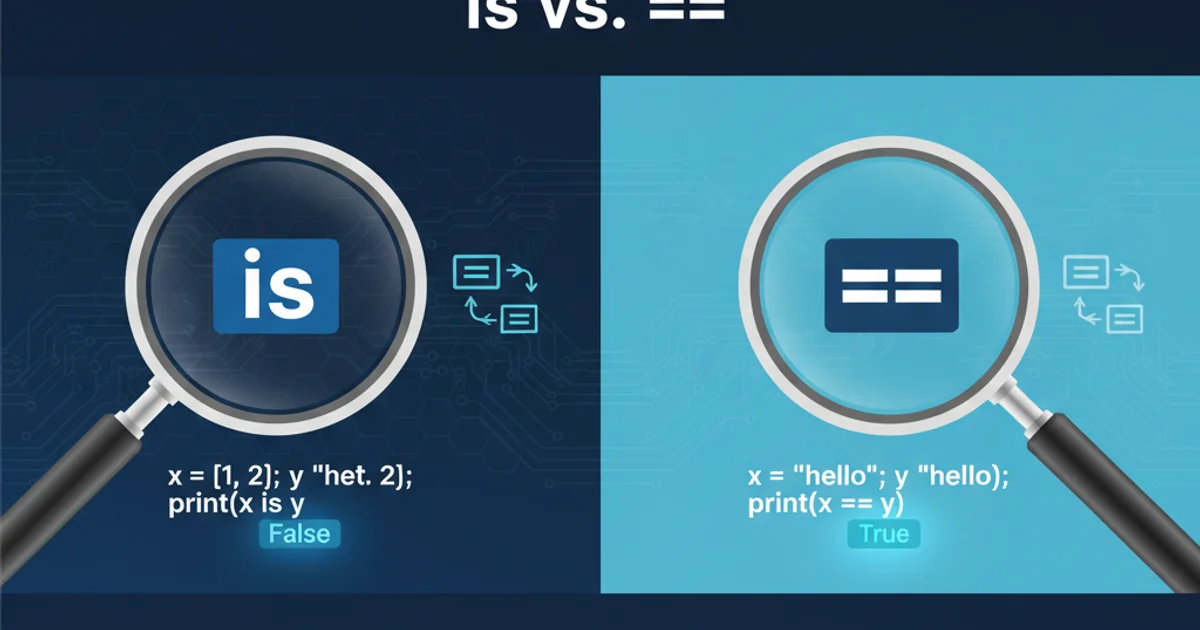String comparison in Python: is vs. ==
Categories:
Python String Comparison: 'is' vs. '==' Explained

Understand the crucial differences between Python's 'is' and '==' operators for string comparison, and learn when to use each for correct and efficient code.
In Python, comparing objects is a fundamental operation, but the choice between the is operator and the == operator can lead to subtle yet significant differences, especially when dealing with strings. While both are used for comparison, they evaluate different aspects of the objects. This article will demystify these operators, explain their underlying mechanisms, and provide clear guidelines on when to use is versus == for string comparisons.
The '==' Operator: Value Equality
The == operator in Python is used to check for value equality. It determines whether the values of two objects are the same. When you use == with strings, Python compares the sequence of characters in each string. If the characters are identical in order and case, the == operator returns True; otherwise, it returns False.
str1 = "hello"
str2 = "hello"
str3 = "world"
print(f"str1 == str2: {str1 == str2}") # True
print(f"str1 == str3: {str1 == str3}") # False
print(f"'Hello' == 'hello': {'Hello' == 'hello'}") # False (case-sensitive)
Demonstrating value equality with the == operator.
The == operator can be overridden by defining the __eq__ method in a class. For built-in types like strings, this method is already implemented to perform character-by-character comparison.
The 'is' Operator: Identity Equality
The is operator, on the other hand, checks for identity equality. It determines whether two variables refer to the exact same object in memory. This means is compares the memory addresses of the objects. If two variables point to the same memory location, is returns True; otherwise, it returns False.
str_a = "python"
str_b = "python"
str_c = "py" + "thon"
str_d = "PYthon".lower()
print(f"str_a is str_b: {str_a is str_b}") # Often True due to interning
print(f"str_a is str_c: {str_a is str_c}") # Often True due to interning
print(f"str_a is str_d: {str_a is str_d}") # Usually False (new object created)
list_a = [1, 2]
list_b = [1, 2]
print(f"list_a is list_b: {list_a is list_b}") # False (different objects, same value)
Illustrating identity equality with the is operator and string interning.
is return True. However, this is an implementation detail and not guaranteed for all strings or all Python versions. Relying on string interning for is comparisons is generally discouraged for correctness.flowchart TD
A[Start Comparison] --> B{Are objects the same memory address?}
B -- Yes --> C["Result: 'is' is True"]
B -- No --> D{Are object values equal?}
D -- Yes --> E["Result: '==' is True"]
D -- No --> F["Result: '==' is False"]
C --> G[End]
E --> G
F --> GDecision flow for 'is' vs. '==' operators.
When to Use Which Operator
The choice between is and == is critical for correct program logic:
Use
==for comparing string values: Almost always, when you want to check if two strings have the same content, you should use==. This is the standard and reliable way to compare string values.Avoid
isfor string comparisons (mostly): Unless you specifically need to check if two string variables refer to the exact same object in memory (which is a rare requirement for strings and often an implementation detail), you should not useis. Relying onisfor string content comparison can lead to unexpected behavior due to string interning, which is not consistently applied.Special case:
Nonecomparison: Theisoperator is commonly and correctly used to check if an object isNone, asNoneis a singleton object in Python. For example:if my_variable is None:.
# Correct usage for value comparison
string_a = "example"
string_b = "example"
print(f"string_a == string_b: {string_a == string_b}") # True
# Incorrect usage for value comparison (due to potential interning issues)
string_c = "long_string_that_might_not_be_interned_1234567890"
string_d = "long_string_that_might_not_be_interned_1234567890"
print(f"string_c is string_d: {string_c is string_d}") # Could be True or False depending on Python version/implementation
print(f"string_c == string_d: {string_c == string_d}") # Always True
# Correct usage for checking against None
my_var = None
if my_var is None:
print("my_var is indeed None")
Best practices for using is and == with strings and None.
is might return True for identical string literals in some cases due to optimization (interning), this behavior is not guaranteed across all Python implementations or for dynamically created strings. Always use == for comparing string content to ensure your code behaves predictably.